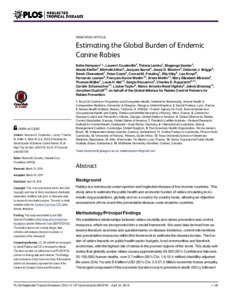Hampson, Katie and Coudeville, Laurent and Lembo, Tiziana and Sambo, Maganga and Kieffer, Alexia and Attlan, Michaël and Barrat, Jacques and Blanton, Jesse D. and Briggs, Deborah J. and Cleaveland, Sarah and Costa, Peter and Freuling, Conrad M. and Hiby, Elly and Knopf, Lea and Leanes, Fernando and Meslin, François-Xavier and Metlin, Artem and Miranda, Mary Elizabeth and Müller, Thomas and Nel, Louis H. and Recuenco, Sergio and Rupprecht, Charles E. and Schumacher, Carolin and Taylor, Louise and Vigilato, Marco Antonio Natal and Zinsstag, Jakob and Dushoff, Jonathan.
(2015)
Estimating the global burden of endemic canine rabies.
PLoS neglected tropical diseases, Vol. 9, H. 4 , e0003709.
![[img]](https://edoc.unibas.ch/style/images/fileicons/application_pdf.png)  Preview |
|
PDF
- Published Version
Available under License CC BY (Attribution).
1205Kb |
Official URL: http://edoc.unibas.ch/dok/A6381843
Downloads: Statistics Overview
Abstract
Rabies is a notoriously underreported and neglected disease of low-income countries. This study aims to estimate the public health and economic burden of rabies circulating in domestic dog populations, globally and on a country-by-country basis, allowing an objective assessment of how much this preventable disease costs endemic countries.; We established relationships between rabies mortality and rabies prevention and control measures, which we incorporated into a model framework. We used data derived from extensive literature searches and questionnaires on disease incidence, control interventions and preventative measures within this framework to estimate the disease burden. The burden of rabies impacts on public health sector budgets, local communities and livestock economies, with the highest risk of rabies in the poorest regions of the world. This study estimates that globally canine rabies causes approximately 59,000 (95% Confidence Intervals: 25-159,000) human deaths, over 3.7 million (95% CIs: 1.6-10.4 million) disability-adjusted life years (DALYs) and 8.6 billion USD (95% CIs: 2.9-21.5 billion) economic losses annually. The largest component of the economic burden is due to premature death (55%), followed by direct costs of post-exposure prophylaxis (PEP, 20%) and lost income whilst seeking PEP (15.5%), with only limited costs to the veterinary sector due to dog vaccination (1.5%), and additional costs to communities from livestock losses (6%).; This study demonstrates that investment in dog vaccination, the single most effective way of reducing the disease burden, has been inadequate and that the availability and affordability of PEP needs improving. Collaborative investments by medical and veterinary sectors could dramatically reduce the current large, and unnecessary, burden of rabies on affected communities. Improved surveillance is needed to reduce uncertainty in burden estimates and to monitor the impacts of control efforts.
| Faculties and Departments: | 09 Associated Institutions > Swiss Tropical and Public Health Institute (Swiss TPH)
09 Associated Institutions > Swiss Tropical and Public Health Institute (Swiss TPH) > Department of Epidemiology and Public Health (EPH) > Human and Animal Health > One Health (Zinsstag) |
|---|
| UniBasel Contributors: | Zinsstag, Jakob Z |
|---|
| Item Type: | Article, refereed |
|---|
| Article Subtype: | Research Article |
|---|
| Publisher: | Public Library of Science |
|---|
| Corporate Creators: | Global Alliance for Rabies Control Partners for Rabies Prevention |
|---|
| ISSN: | 1935-2727 |
|---|
| Note: | Publication type according to Uni Basel Research Database: Journal article |
|---|
| Language: | English |
|---|
| Related URLs: | |
|---|
| Identification Number: | |
|---|
| edoc DOI: | |
|---|
| Last Modified: | 31 Dec 2015 10:58 |
|---|
| Deposited On: | 03 Jul 2015 08:53 |
|---|
Repository Staff Only: item control page


